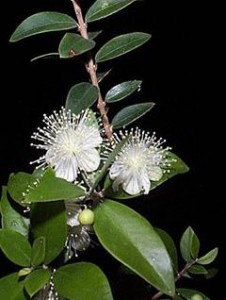Isaiah 55:13: “Instead of the thorn shall come up the fir tree, and instead of the brier shall come up the myrtle tree: and it shall be to the LORD for a name, for an everlasting sign [that] shall not be cut off.”
Throughout history and through the many world cultures myrtle has been a symbol of beauty, love, paradise, immortality, justice, divine presence, peace, prosperity and promise. Myrtle is one of the four plants used to build the Sukkot used by the Jews in the celebration of the Feast of Tabernacles recalling the days they lived in huts (sukkot) during their wanderings in the wilderness. There are two reasons given for the use of myrtle as one of the four plants. The four plants represent a particular member of the body with myrtle representing the eye and the other reason is that myrtle has a sweet smell but no taste to represent Jews who do good deeds but with no knowledge of Torah.
Myrtle obviously played significant role throughout history with its many symbolic and metaphoric usages. So what is God trying to say that instead of the brier shall come up the myrtle tree? Why not the oak tree, it is stronger, or the cedar tree, it is more practical? I mean we are talking metaphors and symbols here, right? In the words of the Prime Minister of Israel Netanyahu’s favorite phrase, “Who says?” I mean would it not create a feeling of peace and security to see the land filled with myrtle trees rather than briers? I believe this has a literal meaning as well as a symbolic meaning.
The word brier in Hebrew is sirepad which appears to come from the same Semitic root סנ which is the same root for the burning bush in Exodus, senah. All these bushes have one thing in common, they have thorns, and they are dried out and easily catch fire. In other words they are dead bushes. If you walk onto a vacant property and see it filled with dead thorny bushes you will instantly think of property that is abandoned. The prophet Isaiah is saying that when Babylon enters and takes the nation of Judah captive, all its lush growth will fall into abandonment and old dead bushes will appear over a desolate land.
But God will one day bring the rains and prosper this land so that the dry dead bushes will disappear and in its place will be myrtle trees. There are many different species of myrtle trees that can range in height from 100 feet to just a bush. Most likely in keeping with the flow of this passage it is referring to the bush type myrtle common in the area. Thus, God is going to replace and old dead thorny bush with something that is alive, beautiful and colorful.
But what about myrtle, what is going through the minds of someone from a Semitic culture living 2,500 years ago in the Near East? Many world cultures assigned meaning to the myrtle which includes beauty, love, paradise, and immortality. It has the idea of creating a balance with nature. Indeed modern science has found that the essential oil myrtle helps to create a balance in one’s hormones which may explain why myrtle was the symbol for the goddess Aphrodite, later known in Roman cultural as Venus. These goddesses were the goddess of fertility, the sexual goddess whose main job was to create a balance between man and woman.
The word myrtle in Hebrew is hadas which was Esther’s Hebrew name and indeed God use her to create a balance between the Hebrew people and the Persian Empire. Prime Minister Netanyahu said in a recent speech to the United Nations that up until the turn of the 20th Century the Jews enjoyed a special friendship with Persia now known as Iran. Mordecai through the inspiration of God chose Esther’s Hebrew name well as she created centuries of balance between the Hebrews and the people of Persia.
Myrtle is used for purification ceremonies both in Hebrew and pagan cultures. Purification is simply purging of things that keep one from having a balance in relationships and health. Indeed, the goddess Aphrodite and Venus were known for their magical healing powers. Julius Caesar wore a myrtle wreath around his head and Roman commanders were often awarded a myrtle wreath to wear. The idea was that the myrtle would purify them of the blood they shed in battle. Actually scientists have found that myrtle can create a hormonal balance with the thyroid. A hormonal imbalance can cause mood swings and depression so often felt by returning warriors and the crown of myrtle that they wore was believed to reduce these feelings of guilt and stress.
The ancient Semitic people were a holistic people; they believed that if you remain in balance with all of nature your health will also come in line. Indeed today there is much holistic thinking arising in our culture as there is a surge in the market for organic and natural foods. More and more people are supplementing their therapy of pills and exercise with eating more natural foods. I heard one physician respond when asked what the best food was and he said, “Anything that was created by God and not a synthetic made by man. What is happening is that we are moving, like the Semitic people, to a more holistic thinking. In other words we are seeking to create a balance with our lives and the creation of God.
That is not a new concept and myrtle is the symbol of this holistic thinking of bringing oneself into balance with God’s creation. Thus Isaiah is saying in 55:13 that God will take what has been put out of balance through man’s sinfulness (briers) and bring it into balance by replacing it with myrtle.
Do you find your life out of balance, filled with sirepads (briers)? Check and see, perhaps God is holding a branch of hadas (myrtle) out to you to bring you into balance with Him. For you see, Jesus is our myrtle tree who died upon a tree to restore our balance with God.
For more information or to purchase Myrtle essential oil visit our link at www.youngliving.org/laurabertone









Recent Comments